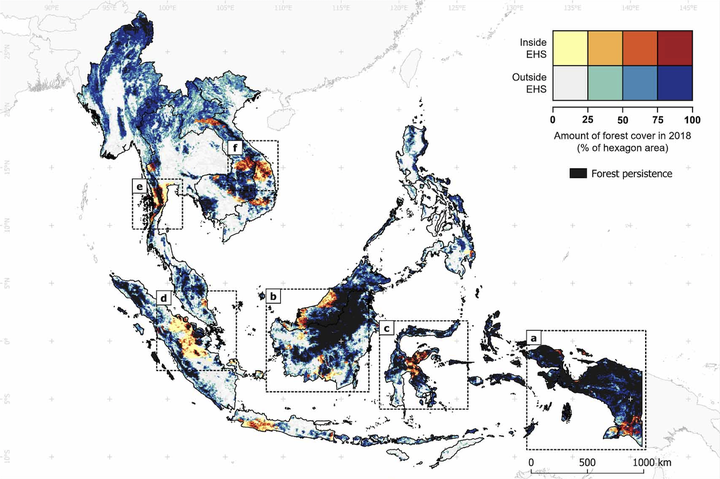Spatiotemporal analysis of deforestation patterns and drivers reveals emergent threats to tropical forest landscapes
 State of SE Asia’s remaining forest in emergent hot spots (EHS). Regional map (top) showing the amount of remaining 2018 ESA forest that occur inside and outside EHS, where each map unit is a 5 km circumradius hexagon (∼65 km2). Insets show the distribution of high, med (medium), and low integrity forest using the 2019 Forest Landscape Integrity Index (FLII) data for hot spots in (a) Papua, (b) Borneo, © Sulawesi, (d) Sumatra, (e) Tenasserim, and (f) southern Laos and central Vietnam.
State of SE Asia’s remaining forest in emergent hot spots (EHS). Regional map (top) showing the amount of remaining 2018 ESA forest that occur inside and outside EHS, where each map unit is a 5 km circumradius hexagon (∼65 km2). Insets show the distribution of high, med (medium), and low integrity forest using the 2019 Forest Landscape Integrity Index (FLII) data for hot spots in (a) Papua, (b) Borneo, © Sulawesi, (d) Sumatra, (e) Tenasserim, and (f) southern Laos and central Vietnam.
Abstract
As deforestation breaches into new tropical frontiers, proactive conservation strategies require a trifecta of information on where deforestation is accelerating (emergent), how drivers of deforestation vary spatiotemporally, and where to focus limited conservation resources in protecting the most integral yet threatened forested landscapes. Here we introduce Emergent Threat Analysis, a process integrating Emerging Hot Spot Analysis of deforestation, visual classification of deforestation outcomes over time, and spatial quantification of contemporary forest condition. We applied Emergent Threat Analysis to tropical Southeast Asia, a global epicentre of biodiversity threatened by deforestation. We found that emergent hot spots (EHS)—a subset of hot spots characterized by strong, recent, and clustered patterns of deforestation—accounted for 26.1% of total forest loss from 1992 to 2018, with deforestation within EHS proceeding at 2.5 times the regional rate of gross loss. Oil palm and rubber plantation expansion were the principal drivers of deforestation within EHS of insular and mainland SE Asia, respectively. Over the study period, oil palm shifted in importance from Sumatra and Sarawak to Papua and Kalimantan, whereas rubber became prominent in Cambodia and Tanintharyi from 2006 to 2015. As of 2019, more than 170000 km2 of SE Asia’s remaining forest occurred within EHS, of which 21.7% was protected. High and medium-integrity forest constituted 19.2% and 49.1% of remaining EHS forest, respectively, but of these, 35.0% of high-integrity and 23.9% of medium-integrity EHS forest were protected. Because we anticipate that tree plantation expansion will continue to drive deforestation in SE Asia, significantly heightened protection is needed to secure the long-term preservation of high and medium-integrity forest, especially in highly contested forest frontier regions. Finally, as a flexible, integrated process, Emergent Threat Analysis is applicable to deforestation fronts across the global tropics.